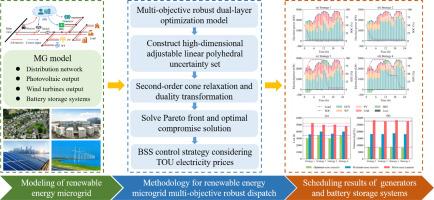A multi-objective robust dispatch strategy for renewable energy microgrids considering multiple uncertainties
IF 10.5
1区 工程技术
Q1 CONSTRUCTION & BUILDING TECHNOLOGY
引用次数: 0
Abstract
The demand for low-carbon transformations and the uncertainty of renewable energy sources and loads present significant challenges for the optimal dispatch of microgrid. This study proposed a multi-objective robust dispatch strategy to reduce the risks associated with the uncertainty of renewable energy source output and loads while promoting low-carbon and economical microgrid operation. The economic emission dispatch problem for a microgrid was formulated as a multi-objective robust dual-layer optimization model. Consequently, a high-dimensional adjustable linear polyhedral uncertainty set was proposed to describe the uncertainty of renewable energy sources and loads. This study transformed the original model into an easy-to-solve single-layer second-order cone programming optimal power flow optimization model by employing second-order cone relaxation and duality transformation. Thereafter, a synthetic membership function was proposed to determine the optimal compromise solution. To determine the charging and discharging statuses of the battery storage system and the electricity traded between the microgrid and the external power grid, a battery storage system control strategy based on time-of-use electricity prices and real-time power flow calculations was proposed. Simulations conducted on a modified IEEE-30 bus system demonstrated that the proposed strategy effectively reduced the economic costs and carbon emissions of the microgrid by 8.23 % and 2.43 %, respectively.

考虑多种不确定性的可再生能源微电网多目标稳健调度策略
低碳转型的需求以及可再生能源和负荷的不确定性给微电网的优化调度带来了巨大挑战。本研究提出了一种多目标鲁棒调度策略,以降低可再生能源输出和负荷不确定性带来的风险,同时促进微电网的低碳和经济运行。微电网的经济排放调度问题被表述为一个多目标鲁棒双层优化模型。因此,提出了一个高维可调线性多面体不确定性集来描述可再生能源和负荷的不确定性。本研究通过二阶圆锥松弛和对偶变换,将原始模型转化为易于求解的单层二阶圆锥程序优化电力流模型。随后,提出了一种合成成员函数来确定最优折中方案。为了确定电池储能系统的充放电状态以及微电网与外部电网之间的电力交易,提出了一种基于分时电价和实时功率流计算的电池储能系统控制策略。在改进的 IEEE-30 总线系统上进行的仿真表明,所提出的策略有效地将微电网的经济成本和碳排放量分别降低了 8.23% 和 2.43%。
本文章由计算机程序翻译,如有差异,请以英文原文为准。
求助全文
约1分钟内获得全文
求助全文
来源期刊

Sustainable Cities and Society
Social Sciences-Geography, Planning and Development
CiteScore
22.00
自引率
13.70%
发文量
810
审稿时长
27 days
期刊介绍:
Sustainable Cities and Society (SCS) is an international journal that focuses on fundamental and applied research to promote environmentally sustainable and socially resilient cities. The journal welcomes cross-cutting, multi-disciplinary research in various areas, including:
1. Smart cities and resilient environments;
2. Alternative/clean energy sources, energy distribution, distributed energy generation, and energy demand reduction/management;
3. Monitoring and improving air quality in built environment and cities (e.g., healthy built environment and air quality management);
4. Energy efficient, low/zero carbon, and green buildings/communities;
5. Climate change mitigation and adaptation in urban environments;
6. Green infrastructure and BMPs;
7. Environmental Footprint accounting and management;
8. Urban agriculture and forestry;
9. ICT, smart grid and intelligent infrastructure;
10. Urban design/planning, regulations, legislation, certification, economics, and policy;
11. Social aspects, impacts and resiliency of cities;
12. Behavior monitoring, analysis and change within urban communities;
13. Health monitoring and improvement;
14. Nexus issues related to sustainable cities and societies;
15. Smart city governance;
16. Decision Support Systems for trade-off and uncertainty analysis for improved management of cities and society;
17. Big data, machine learning, and artificial intelligence applications and case studies;
18. Critical infrastructure protection, including security, privacy, forensics, and reliability issues of cyber-physical systems.
19. Water footprint reduction and urban water distribution, harvesting, treatment, reuse and management;
20. Waste reduction and recycling;
21. Wastewater collection, treatment and recycling;
22. Smart, clean and healthy transportation systems and infrastructure;
 求助内容:
求助内容: 应助结果提醒方式:
应助结果提醒方式:


